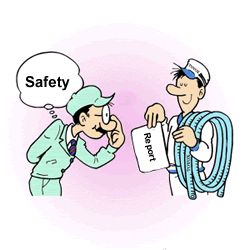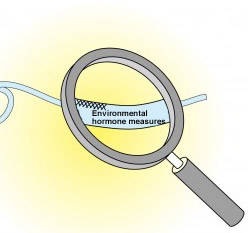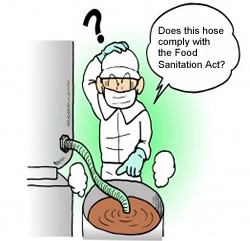Hose and Coupling Knowledge Base
If You Register to Become a Web Member, We Will Send You the Latest Information on Hoses and Coupling.
About REACH, RoHS, Endocrine Disruptor & the Food Sanitation Act
We also look at REACH and RoHS, two important documents on chemical substances, including what they stand for and what will happen in the future. To make all this information easy to understand, we have broken it down into a mini FAQ below. We hope this will make these concepts clear.

Q1: I have been hearing a lot about regulations for harmful chemical substances such as the RoHS directive and the REACH regulations, and I am concerned about the safety of hoses and couplings. How do these regulations affect the hoses I’m currently using, and where is this all headed?
A1: The RoHS directive and the REACH regulations are legal regulations in the EU. RoHS provides regulations for electronic and electrical equipment and do not apply directly to hose and coupling products. When a hose or coupling is built into an electronic or electrical device exported into an EU country, however, RoHS may apply. The RoHS directive currently regulates six substance groups, none of which are used by Toyox. The REACH regulations cover all chemical substances (about 130,000), but do not specify any new restricted substances (only those already restricted, such as asbestos and cadmium). At the current stage, dozens of substances are being investigated for possible restriction under the classification “substances of very high concern” (SVHCs).
Toyox understands these concerns about harmful chemical substances. In response to inquiries from our customers, we are happy to provide a “Chemical Substance Content Study Report” containing information on the substances contained in our products. The number of restricted substances is expected to increase, and Toyox will be ready to ensure our products are compliant.

[Explanation of terms]
Restriction of Hazardous Substances Directive (RoHS):
With the primary aim of minimizing the danger to the environment and human health at each stage of an electrical or electronic device’s life, from production to disposal, the RoHS directive designates dangerous substances contained in devices and regulates how much of those substances can be used in the EU. There are currently six substances prohibited by the RoHS: lead, mercury, cadmium, hexavalent chromium, polybrominated biphenyls (PBB) and polybrominated diphenyl ether (PBDE).
Registration, Evaluation, Authorization and Restriction of Chemicals (REACH) :
A chemical regulation in the EU, REACH aims to maintain human health and protect the environment. REACH obliges manufacturers and importers to conduct studies on the effects on humans and the global environment of chemicals (new or existing) to be sold in the EU, and also to file an application and register. Restricted substances (some of which are published by the European Chemicals Agency) require authorization by the European Chemicals Agency.
Q2: I no longer see the marking on Toyox hoses indicating measures are taken for environmental hormones. Are you no longer taking those measures?
A2: Initially, we used that to indicate that environmental hormones are not in the materials we use for our hoses, but the Japanese Ministry of the Environment issued a policy change saying that the restrictive description “environmental hormones” was not appropriate, so we stopped using it on the hoses. We do, however, continue to use that expression when discussing precautions for food products and other processing. For food products, we recommend using food-grade hoses.
[Explanation of terms]
Environmental hormones:
Hormones thought to have a disruptive effect on endocrine secretions in the body. Known more properly as endocrine disruptors or endocrine disrupting compounds, there are 67 currently under study. The Environmental Agency (currently the Ministry of the Environment) began a study into environmental hormones in 1998 in a project known as Speed 98. No clear conclusion was reached, however, and in 2005, the scope was widened to include carcinogenicity and bioaccumulation under the project renamed as ExTEND 2005.

Q3: How does the Food Sanitation Act treat environmental hormones?
A3: The Food Sanitation Act is under the purview of the Ministry of Health, Labour and Welfare. The Ministry of the Environment is not involved in environmental hormones.
The only substance designated as questionable is phthalate di 2-ethylhexyl because of carcinogenicity and other toxicity. Its use was restricted in oils and fats, as well as food-grade vinyl chloride products that come into contact with oily/fatty foods by Public Notice No. 267 issued by the Ministry of Health, Labour and Welfare in 2002.
Toyox food-grade hoses do not contain phthalate di 2-ethylhexyl.
For more information on the Food Sanitation Act and hoses, click here.
Also see the selection table Also see Q2 for more information on environmental hormones.
Archive
How to Cut Steel-Wire-Reinforced PVC Hose
Does Electricity Conservation Increase Condensation?
Why Do Hoses Leak & Disconnect?
Can PVC & Other Plastic Hoses Be Used for Fuel Gas & Kerosene?
How to Read Catalog Specifications, Part 4 – Are Hose Sizes Random?
How to Read Catalog Specifications, Part 3 – Minimum Bend Radius
Beware of Static Electricity on Hoses
How to Read Catalog Specifications, Part 2 – Negative Pressure+B10
About REACH, RoHS, Endocrine Disruptor & the Food Sanitation Act
How to Read Catalog Specifications, Part 1 – Use Pressure
How to Avoid Damage Caused by Ultraviolet Rays
The Dangers of Hose Condensation
Why Transparent Hoses Become Cloudy
Leaks & Disconnections Due to Mismatched Couplings & Hoses
Causes & Solutions for Leaks & Disconnections
The Benefits of the Right Hose for the Situation (2)









